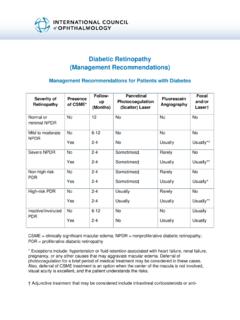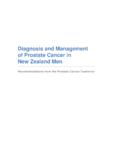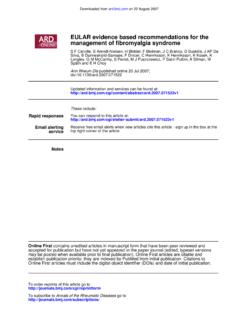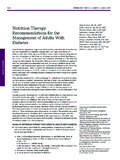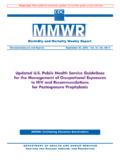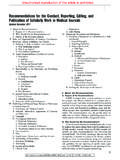Transcription of Diagnosis and Management of Q Fever — United …
1 Diagnosis and Management of Q Fever United States, 2013 recommendations from CDC and the Q Fever Working Group Continuing Education Examination available at recommendations and Reports / Vol. 62 / No. 3 March 29, 2013 Department of Health and Human ServicesCenters for Disease Control and PreventionMorbidity and Mortality Weekly ReportRecommendations and ReportsFront cover photo: A girl plays with goats, one of the primary reservoirs of Coxiella burnetii, the bacterium that causes the zoonotic disease Q MMWR series of publications is published by the Office of Surveillance, Epidemiology, and Laboratory Services, Centers for Disease Control and Prevention (CDC), Department of Health and Human Services, Atlanta, GA Citation: Centers for Disease Control and Prevention.
2 [Title]. MMWR 2013;62(No. RR-#):[inclusive page numbers].Centers for Disease Control and PreventionThomas R. Frieden, MD, MPH, DirectorHarold W. Jaffe, MD, MA, Associate Director for ScienceJames W. Stephens, PhD, Director, Office of Science QualityDenise M. Cardo, MD, Acting Deputy Director for Surveillance, Epidemiology, and Laboratory ServicesStephanie Zaza, MD, MPH, Director, Epidemiology and Analysis Program OfficeMMWR Editorial and Production StaffRonald L. Moolenaar, MD, MPH, Editor, MMWR SeriesChristine G.
3 Casey, MD, Deputy Editor, MMWR SeriesTeresa F. Rutledge, Managing Editor, MMWR SeriesDavid C. Johnson, Lead Technical Writer-EditorCatherine B. Lansdowne, MS, Project EditorMartha F. Boyd, Lead Visual Information SpecialistMaureen A. Leahy, Julia C. Martinroe, Stephen R. Spriggs, Terraye M. StarrVisual Information SpecialistsQuang M. Doan, MBA, Phyllis H. KingInformation Technology SpecialistsMMWR Editorial BoardWilliam L. Roper, MD, MPH, Chapel Hill, NC, ChairmanMatthew L. Boulton, MD, MPH, Ann Arbor, MIVirginia A.
4 Caine, MD, Indianapolis, INBarbara A. Ellis, PhD, MS, Atlanta, GAJonathan E. Fielding, MD, MPH, MBA, Los Angeles, CADavid W. Fleming, MD, Seattle, WAWilliam E. Halperin, MD, DrPH, MPH, Newark, NJKing K. Holmes, MD, PhD, Seattle, WATimothy F. Jones, MD, Nashville, TNRima F. Khabbaz, MD, Atlanta, GADennis G. Maki, MD, Madison, WIPatricia Quinlisk, MD, MPH, Des Moines, IAPatrick L. Remington, MD, MPH, Madison, WIJohn V. Rullan, MD, MPH, San Juan, PRWilliam Schaffner, MD, Nashville, TNCONTENTSI ntroduction.
5 1 Methods ..2 Epidemiology ..3 Assessment of Clinical Signs and Symptoms ..4 Diagnosis ..9 Treatment and Management ..12 Occupational Exposure and Prevention ..16 Surveillance and Reporting ..19 Acknowledgments ..20 References ..20 Appendix A ..24 Appendix B ..26 Appendix C ..27 Appendix D ..28 Disclosure of RelationshipCDC, our planners, and our content experts disclose that they have no financial interests or other relationships with the manufacturers of commercial products, suppliers of commercial services, or commercial supporters.
6 Presentations will not include any discussion of the unlabeled use of a product or a product under investigational use. CDC does not accept commercial and ReportsMMWR / March 29, 2013 / Vol. 62 / No. 3 1 IntroductionQ Fever , first described in 1937, is a worldwide zoonosis that has long been considered an underreported and underdiagnosed illness because symptoms frequently are nonspecific, making Diagnosis challenging (1 3). The causative organism, Coxiella burnetii, is an intracellular bacterium that tends to infect mononuclear phagocytes but can infect other cell types as well.
7 Infection in humans usually occurs by inhalation of bacteria from air that is contaminated by excreta of infected animals. Other modes of transmission to humans, including tick bites, ingestion of unpasteurized milk or dairy products, and human-to-human transmission, are rare (1). Laboratory Diagnosis relies mainly on serology, and doxycycline is the most effective treatment for acute illness. No vaccine is available commercially in the United Fever was designated a nationally notifiable disease in the United States in 1999.
8 Since then, reports of Q Fever have increased, with 167 cases reported in 2008, an increase greater than ninefold compared with 2000, in which 17 cases were reported (4). The national seroprevalence of Q Fever is estimated to be based on data from the National Health and Nutrition Examination Survey (2003 2004), and human infections have been reported from every state in the United States (5). Q Fever infections in humans and animals have been reported from every world region except Antarctica (6).
9 Q Fever has acute and chronic stages that correspond to two distinct antigenic phases of antibody response. During an acute infection, an antibody response to C. burnetii phase II antigen is predominant and is higher than the response to the phase I The material in this report originated in the National Center for Emerging and Zoonotic Infectious Diseases, Beth P. Bell, MD, Director; and the Division of Vector-Borne Diseases, Lyle R. Petersen, MD, Director. Corresponding preparer: Alicia Anderson, DVM, Division of Vector-Borne Diseases, National Center for Emerging and Zoonotic Infectious Diseases, CDC, 1600 Clifton Road, MS A-30, Atlanta, GA 30333.
10 Telephone: 404-639-4499; Fax: 404-639-2778; E-mail: and Management of Q Fever United States, 2013 recommendations from CDC and the Q Fever Working GroupAlicia Anderson, DVM1 Henk Bijlmer, MD, PhD2 Pierre-Edouard Fournier, MD, PhD3 Stephen Graves, MD, PhD4 Joshua Hartzell, MD5 Gilbert J. Kersh, PhD1 Gijs Limonard, MD6 Thomas J. Marrie, MD7 Robert F. Massung, PhD1 Jennifer H. McQuiston, DVM1 William L. Nicholson, PhD1 Christopher D. Paddock, MD1 Daniel J. Sexton, MD8 1 National Center for Emerging and Zoonotic Infectious Diseases, CDC, Atlanta, Georgia2 National Institute for Public Health and the Environment, The Netherlands3 French National Center for the Study and Diagnosis of Q Fever , Facult de M decine, Marseille, France4 Australian Rickettsial Reference Laboratory Foundation, Victoria, Australia5 Walter Reed National Military Medical Center, Washington, DC6 Canisius-Wilhelmina Hospital, Nijmegen, The Netherlands7 Dalhousie University.










